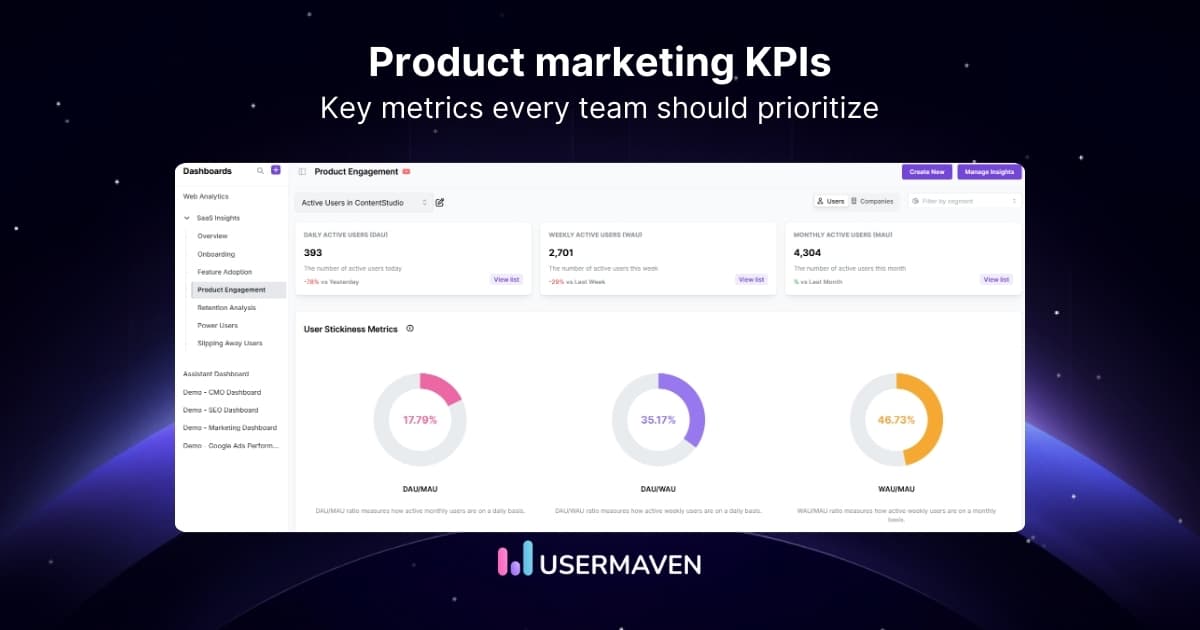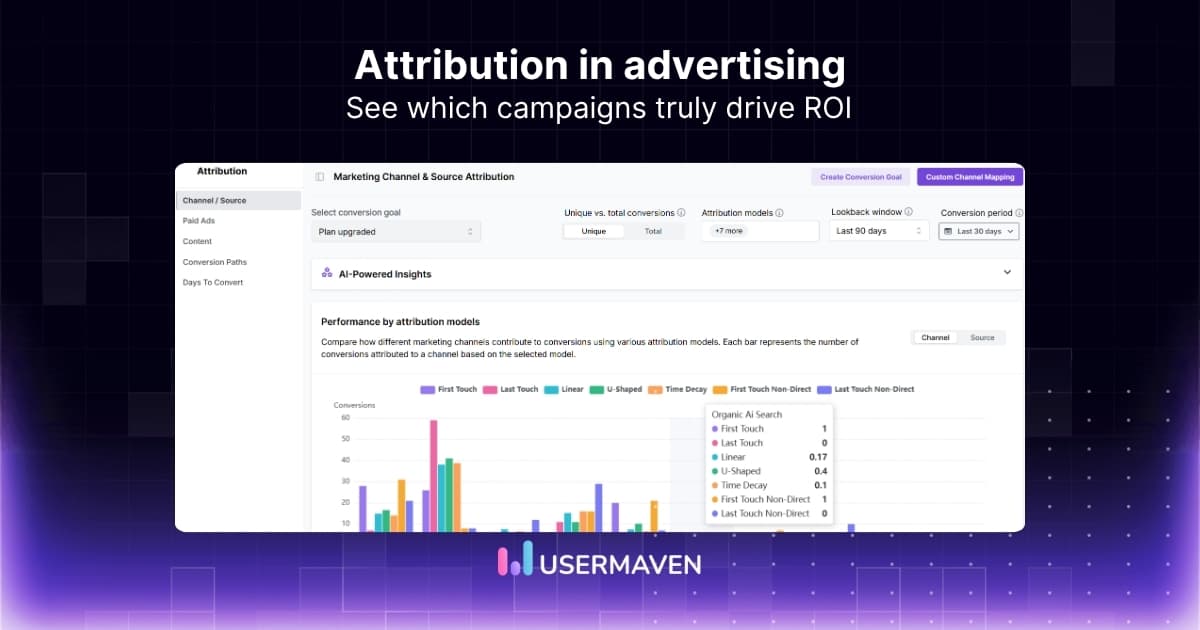Understanding the importance of goal-tracking in SaaS
Apr 5, 2024
3 mins read
Written by Mahnoor Shahid
Do you want your SaaS business to win?
Goal-tracking is like having a map. It shows you where you’re going and if you’re on the right track.
This blog will explain why goal-tracking is important for your SaaS business. We’ll show you how it can help you:
Get more users to love your product!
Make your product even better!!
Win the game! (become a successful business)
What are goals?
Goals help you understand how users interact with your platform and whether they find value in it. They’re specific actions users take that signal they’re completing a desired task relevant to your service.
These tasks can vary depending on what your SaaS platform offers. Here are some examples:
- Project management tool: Completing a project, adding tasks to a project, inviting team members.
- Marketing automation platform: Launching an email campaign, creating landing pages, and managing subscriber lists.
- Content management system: Publishing a blog post, creating new website pages, managing user accounts.
By tracking goals, you can see which functionalities and features are most engaging and where users might encounter difficulties. This information helps you improve your SaaS platform and provide a better user experience, ultimately increasing user satisfaction and retention.
Why is goal-tracking important?
Goal-tracking is essential for several reasons:
- Measures progress: Goals provide a clear benchmark to assess whether your efforts are paying off. By monitoring goal completion rates, you can gain valuable insights into user behavior and the effectiveness of your marketing campaigns.
- Improves decision-making: Data gathered through goal-tracking empowers you to make informed decisions about product development, marketing strategies, and resource allocation.
- Identifies areas for improvement: By analyzing goal completion rates for different user segments or features, you can pinpoint areas where your platform might be underperforming. This allows you to focus your efforts on optimization and improvement.
How can SaaS analytical platforms help?
SaaS analytical platforms like Usermaven provide a robust framework for tracking and analyzing goals. These platforms offer features like:

- Goal creation: Define specific actions you want users to take on your platform.
Related: Guide to setting up conversion goals
- Data visualization: Track goal progress over time through insightful dashboards and reports.
- Segmentation: Analyze goal completion rates for different user groups to identify trends and patterns.
- Attribution modeling: Understand which marketing channels are driving the most conversions.
Related: Understanding user acquisition reports
How to create goals?
- Identify your goals: What actions do you want users to take on your platform? These could include signing up for a free trial, making a purchase, or completing a specific task.
- Log in to Usermaven: Access your Usermaven dashboard.
- Find the goal creation section: Scroll down to website analytics and see “Conversion Goals.”
- Create a new goal: Usermaven has a button to create a new goal.
- Configure your goal settings: Usermaven will guide you through defining the specifics of your goal, such as:
- Goal name: Choose a clear and descriptive name for your goal.
- Add condition: Select the event type or action that signifies a goal completion (e.g., visiting a specific page, clicking a button).
How to track goals?
- Usermaven automatically tracks: Once you’ve created a goal, Usermaven will start tracking it automatically.
- Locate goal reports: Usermaven offers reports and dashboards to view your goal-tracking data.
- Analyze your data: Usermaven will present your goal data in various formats, such as charts and tables. You can see things like:
- Activity: How many users took the desired action?
- Goal value: The percentage of users who completed the goal.
- Conversion rate: How goal completions are changing over time.
By analyzing your goal data, you can gain valuable insights into user behavior and the effectiveness of your platform.
The SMART way to track goals
Let’s say you run a SaaS company that offers a design tool. Understanding user activation is crucial for your business. An activated user has gone beyond simply signing up for an account and begun to engage with the core features that provide value.
Here’s a SMART goal example for tracking user activation:
- Specific: Increase the percentage of new users who complete a design project within their first 7 days on the platform by 10%.
Related: Importance of active users
- Measurable: You’ll track the completion rate of design projects for new users within a 7-day window. This completion rate can be a percentage of total new users.
- Achievable: This goal is ambitious but achievable by improving the onboarding process, offering in-app tutorials, or highlighting project templates.
- Relevant: User activation is directly tied to the success of your design tool. Getting users to create projects early makes them more likely to see the value and become paying customers.
- Time-bound: The goal has a timeframe of 7 days to focus efforts on the critical early user experience.
By tracking this SMART goal, you can measure the effectiveness of your efforts to activate new users and iterate on your onboarding process to improve those rates. This will lead to a more engaged user base and a more successful SaaS business.
Benefits of goal setting
Setting goals can be a powerful tool for achievement and personal growth. Here are some ways it can help you:

- Sharpen your focus: Goals help you identify what’s important and prioritize your efforts. This can be especially useful when you have a lot on your plate.
- Boost motivation: Having a clear goal in mind can give you a sense of direction and purpose. It can help you stay energized and keep moving forward, even when things get tough.
- Level up your organization: The process of setting goals often involves planning and strategizing. This can help you organize and develop a roadmap for achieving your desires.
- Increase your confidence: Reaching a goal is a rewarding experience. It shows you what you’re capable of and can boost your confidence.
End-note
This blog explained why tracking goals is key to winning with your SaaS. Just like tracking points in a game, goals show you how you’re doing. By seeing what users love (and what confuses them), you can make your SaaS even better.

FAQs
1. Why should I track goals for my SaaS business?
Tracking goals helps you see how your SaaS business is doing, what’s working well, and what needs improvement. It’s like a compass that points you in the right direction for success.
2. What kind of goals should I set for my SaaS business?
Goals should focus on things like getting new users, keeping users happy, and making more money. You could set goals for features people love, how long they spend using your SaaS, and even money earned from subscriptions.
3. How do I know if my SaaS business is hitting its goals?
You can use tools like Usermaven to keep an eye on your progress. If the numbers show that users love using your SaaS, they stay longer and invite others, and your income is growing, then you’re on the right track!
Try for free
Grow your business faster with:
- AI-powered analytics & attribution
- No-code event tracking
- Privacy-friendly setup


